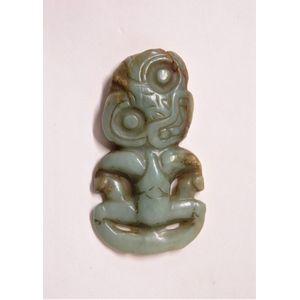Ivory Chinese Sage Figure with Character Marks
You must be a subscriber, and be logged in to view price and dealer details.
Subscribe Now to view actual auction price for this item
When you subscribe, you have the option of setting the currency in which to display prices to $Au, $US, $NZ or Stg.
- Ivory - Ivory is a hard white material that comes from the tusks of elephants, mammoth, walrus and boar, or from the teeth of hippopotamus and whales. The ivory from the African elephant is the most prized source of ivory. Although the mammoth is extinct, tusks are still being unearthed in Russia and offered for sale.
Ivory has been used since the earliest times as a material for sculpture of small items, both in Europe and the east, principally China and Japan.
In Asia ivory has been carved for netsuke, seals, okimono, card cases, fan supports, animals and other figures and even as carved tusks.
In the last 200 years in Europe ivory has been used to carve figures, for elaborate tankards, snuff boxes, cane handles, embroidery and sewing accessories, in jewellery and as inlay on furniture. Its more practical uses include being used for billiard balls, buttons, and a veneers on the top of piano keys.
The use and trade of elephant ivory have become controversial because they have contributed to Due to the decline in elephant populations because of the trade in ivory, the Asian elephant was placed on Appendix One of the Convention on International Trade in Endangered Species (CITES), in 1975, and in January 1990, the African elephant was similarly listed. Under Appendix One, international trade in Asian or African elephant ivory between member countries is forbidden. Unlike trade in elephant tusks, trade in mammoth tusks is legal.
Since the invention of plastics, there have been many attempts to create an artificial ivory
Visually similar items

An ivory figure of a maiden, late 19th/20th century, (2) standing, holding a fly whisk in her left hand and a vessel in the right, wearing a long robe and trailing scarf draped around her high coiled coiffure and falling to either side, a tasselled ornamen

A pair of Professor Eugenio Pattarino (Italian 1885-1971) impressive ceramic blackamoor candelabra, hand painted and gilded ceramic, the Venetian glass branches with gilded inclusions, including finial 120 cm high. Provenance: The collection of a Curator

An uncommon pre-European Maori carved inunga pounamu hei tiki, good proportions and traditional form, chin to the left, hands to thighs, three tapered hourglass drilled and concealed suspension holes to the back top of head, one broken through, natural dar

A Royal Worcester vitreous china figure of a water carrier, 1891 in a draped gilded robe kneeling with an urn on her hip, 15 cm high. Printed green factory mark, impressed numbers 01/01. Provenance: Private collection NSW
